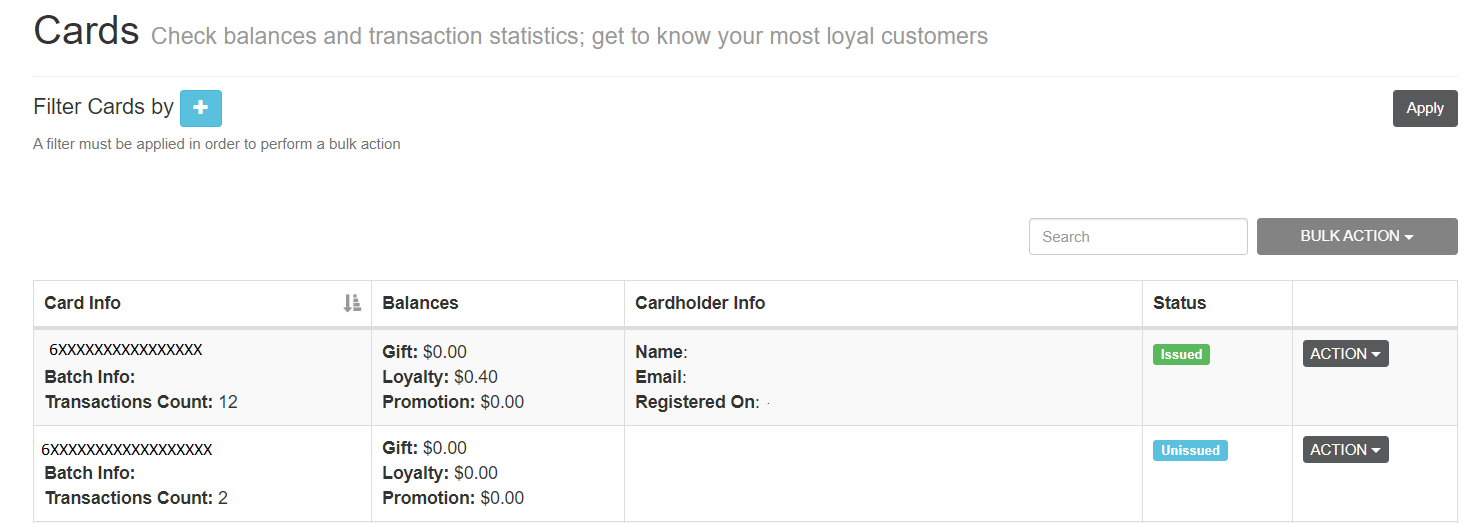In this article, you will learn how to manage cards, and perform a variety of actions.
To view Cards, visit https://manage.ackroo.com and sign in. This will bring you to the Ackroo Anywhere homescreen. In order to view a list of cards and perform actions, select Cards.

Managing Cards
From the Manage Cards page, it is possible to view a list of all cards that have been added to the program, as well as perform actions on single cards and/or multiple cards at once.

- Cards can be individually searched by using the search function, or you can filter your cards with the various options listed here.
Perform an Action with a Card
Each Card has an 'ACTION' button to the right of the row. See the various actions explained HERE. Options include:
- View Details
- Edit Profile
- Issue / Unissue
- Block / Unblock
- Disable Transaction Count Limit
- Transfer Funds
- Add Promotional Funds
- Clear Loyalty Funds
- Status (see Card States)
- It is also possible to perform an action on multiple cards. This is called a Bulk Action.
Batch Info/ Ackroo ID
If your cards were printed by Ackroo, you can find the Ackroo ID on the back of the card, below the card number. In newer print versions (as of 2019), this field is now referred to as the Batch Info field.
("Ackroo-ID" - Old Ackroo Cards)

("Batch Info" - New Ackroo Cards)

The Ackroo ID/Batch Info is a unique secondary number on each card that sequentially identifies a range of cards.
- The number before the dash is the specific sequential card number
- The number after the dash is the batch number for the entire group of cards printed
From the example pictured above, the Ackroo ID/Batch Info 987-65432 represents:
- Card number 987 of Batch 65432.
- If Batch 65432 was generated for a total of 1000 cards, the Ackroo ID's would range from 1-65432 to 1000-65432.
Note: If your cards were not printed by Ackroo and were imported from another provider into the Ackroo Anywhere platform, the Batch Info will be assigned in our database, but will not be printed on the cards. You can easily find this number within the management dashboard
Card States
There are 3 states that cards can be in; unissues, issued and blocked. Examples of what these look like are pictured below.

- Unissued cards need to be issued before any transactions can be made on the card.
- Unissued cards can be:Issued, Blocked

- Issued cards have been issued and can receive transactions.
- Issued cards can be: Blocked

- Blocked cards cannot receive any transactions.
- Blocked cards can be: Unblocked
Tables can't be imported directly. Please insert an image of your table which can be found here.
NEW OLD Issued
↕
Blocked
| NEW | OLD |
| Unissued | Deactivated with 0 transactions |
| Issued <-> Blocked | Active <-> Deactivated with X transactions |
Cardholder
| State | Balance Check | WLP Registration | Balance Transfer Out | Balance Transfer In |
| Unissued | Not Allowed | Not Allowed | Not Allowed | Allowed -> Issued |
| Issued | Allowed | Allowed | Allowed -> Blocked | Allowed |
| Blocked |
Allowed Custom Message |
Allowed Custom Message |
Not Allowed | Not Allowed |
Point-of-Sale
| State | Redeem/Spend | Issue/Activate |
Credit/Fund/ Reload |
| Unissued | Not Allowed | Allowed -> Issued | Not Allowed (merchant settings) |
| Issued | Allowed | Not Allowed | Allowed |
| Blocked | Not Allowed | Not Allowed | Not Allowed |
Program Console
| State | Management State Change |
| Unissued |
Issue -> Issued Block -> Blocked |
| Issued |
Block -> Blocked Balance Transfer -> Blocked Reverse Issue -> Unissued |
| Blocked |
Unblock -> Issued Balance Transfer -> Blocked |
